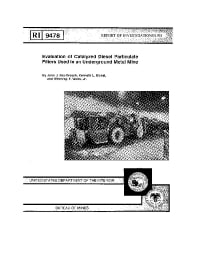Mining Publication: Evaluation of Catalyzed Diesel Particulate Filters Used in an Underground Metal Mine
Original creation date: January 1993
Authors: JJ Baz-Dresch, KL Bickel, WF Watts
NIOSHTIC2 Number: 10004327
U.S. Department of the Interior, Bureau of Mines, Report of Investigations 9478, 1993 Jan:1-13
Catalyzed diesel particulate filters (CDPF's) reduce the concentration of diesel particulate matter (DPM) and may reduce the emissions of carbon monoxide (CO) and hydrocarbons (HC) in diesel exhaust. Asamera Minerals' Cannon Mine first installed CDPF's in 1987, and currently has 12 diesel powered vehicles equipped with CDPF's. The Cannon Mine and the U.S. Bureau of Mines collaborated to evaluate the durability and performance of a CDPF. One of the CDPF's used at the mine was periodically evaluated in the USBM's diesel emissions laboratory after 839, 1,584, and 2,881 h of in-mine service. The objectives of this report are to present results from the USBM's evaluation of this CDPF, to describe the Cannon Mine's experience and cost analysis of using CDPF's, and to make recommendations for the future use of CDPF's. CDPF's improve air quality at the Cannon Mine, but they frequently become plugged and are subject to excessive mechanical shocks and stress, shortening their useful life. Mine records indicate that CDPF's account for 0.8 to 4.9 pct of the vehicles' operating cost at the mine. CDPF life to date has ranged from 1,671 h to more than 5,992 h. Laboratory tests of the CDPF determined that DPM removal efficiency decreased and regeneration temperature increased over time.

NIOSHTIC2 Number: 10004327
U.S. Department of the Interior, Bureau of Mines, Report of Investigations 9478, 1993 Jan:1-13
- CO and CO2 Emissions from Spontaneous Heating of Coal Under Different Ventilation Rates
- CO Dispersion from a Coal Fire in a Mine Entry
- DEEP Project on Evaluation of Diesel Particulate Filters at Inco's Stobie Mine
- Effects of Diesel Exhaust Aftertreatment Devices on Concentrations and Size Distribution of Aerosols in Underground Mine Air
- Effects of Sintered Metal Diesel Particulate Filter System on Diesel Aerosols and Nitric Oxides in Mine Air
- Factors Affecting ANFO Fumes Production
- Monitoring and Removal of CO in Blasting Operations
- Mutagenicity of Diesel Exhaust Particles from an Engine with Differing Exhaust After Treatments
- Sampling Results of the Improved SKC� Diesel Particulate Matter Cassette
- Smoke, Carbon Monoxide, and Hydrogen Chloride Production from the Pyrolysis of Conveyor Belting and Brattice Cloth